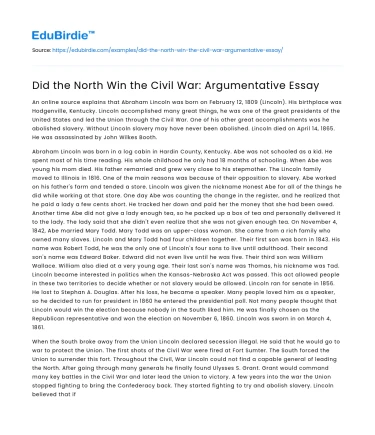Introduction
The American Civil War, a pivotal event in the history of the United States, is often characterized by the dichotomy between the industrialized North and the agrarian South. This conflict, fought from 1861 to 1865, resolved fundamental questions about the sovereignty of states and the institution of slavery. The prevailing narrative is that the North emerged victorious, a viewpoint supported by the eventual abolition of slavery and the preservation of the Union. However, this conclusion invites scrutiny: did the North truly 'win' in every aspect of the war? This essay aims to evaluate the extent of the Northern victory by examining the immediate military success, the achievement of strategic goals, and the long-term socio-economic impacts. Through an exploration of these dimensions, it becomes evident that while the North achieved a military and political triumph, the Southern legacy and enduring societal divisions cast shadows over the notion of an unequivocal victory.
Military Success and Strategic Goals
From a military standpoint, the North's triumph in the Civil War is indisputable. The Union's superior industrial capacity, larger population, and more extensive railway network were instrumental in sustaining a protracted military campaign. According to historian James McPherson, the Union's ability to mobilize resources and manpower was a crucial factor in its success ("Battle Cry of Freedom"). The North's strategic victories at Gettysburg and Vicksburg in 1863 marked turning points, crippling the Confederacy's ability to wage war effectively. These victories decimated Southern morale and hindered their capacity to procure necessary supplies, thereby undermining their war effort.
Save your time!
We can take care of your essay
- Proper editing and formatting
- Free revision, title page, and bibliography
- Flexible prices and money-back guarantee
Moreover, the leadership of figures such as Ulysses S. Grant and William Tecumseh Sherman, who implemented a strategy of total war, further solidified the North's military dominance. Sherman's March to the Sea, for instance, exemplified the application of total war principles aimed at devastating the South's will to fight. By undermining civilian infrastructure and demoralizing the Southern populace, the North effectively dismantled the Confederate resistance. The military surrender of the Confederate forces in 1865, epitomized by General Robert E. Lee's capitulation at Appomattox Court House, confirmed the Union's military victory and the achievement of its strategic objectives.
However, some historians argue that while the North won militarily, they faced challenges in translating military success into political stability. The post-war Reconstruction era exposed the complexities of reintegrating the Southern states and ensuring civil rights for freed slaves. This suggests that while the North achieved its strategic goals of preserving the Union and abolishing slavery, the victory was fraught with difficulties in implementation, casting doubt on a wholly triumphant outcome.
Socio-Economic Impacts and Legacy
The socio-economic aftermath of the Civil War further complicates the narrative of Northern victory. The abolition of slavery was a monumental achievement, yet it gave rise to new challenges. The Reconstruction era (1865-1877) was marred by significant resistance from Southern states, which implemented Jim Crow laws to suppress African American rights. This resistance highlights the limitations of Northern victory in achieving lasting social justice and equality.
The North's economic model, predicated on industrialization, became dominant nationwide. However, the South's economy, reliant on agriculture and devastated by the war, struggled to recover. Historian Eric Foner notes that the economic disparity between North and South persisted, contributing to regional tensions ("Reconstruction: America's Unfinished Revolution"). Although the North's economic policies triumphed, the socio-economic integration of the South remained incomplete. This incomplete integration underscores the multifaceted nature of the Northern victory, which was not absolute but rather a complex interplay of success and ongoing challenges.
Furthermore, the enduring legacy of racial discrimination and segregation, perpetuated through systemic mechanisms, reveals the limitations of the North's socio-political triumph. The Civil Rights Movement of the 1960s, nearly a century later, underscores the protracted struggle for equality and the unfinished business of the Civil War. The North's inability to secure immediate and comprehensive social change post-war reflects the partial nature of its victory, as full societal integration remained elusive for decades.
Conclusion
In conclusion, the North's victory in the American Civil War is multifaceted, encompassing both definitive military success and complex socio-political challenges. While the Union's military strategies and leadership secured a decisive victory over the Confederate forces, the post-war period revealed significant hurdles in achieving lasting socio-economic integration and equality. The abolition of slavery marked a critical step forward, yet the persistent racial and regional tensions illustrate the limitations of the Northern triumph. Thus, the North's victory, while significant, was not absolute, as the legacy of the Civil War continued to shape American society for generations. In evaluating the Northern triumph, it is essential to recognize the war's enduring impact and the ongoing quest for equality and reconciliation in the United States.






 Stuck on your essay?
Stuck on your essay?

